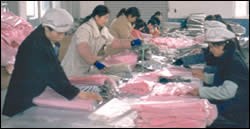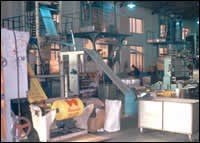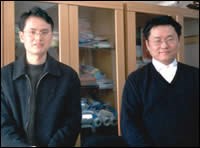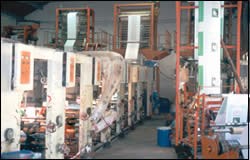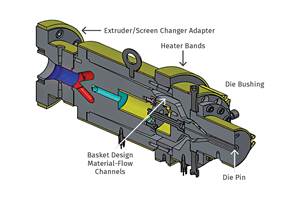Solving the Puzzle of Chinese Bags
How do the Chinese get such high quality at such low cost? They have been accused of dumping, but Chinese bag makers are mostly small mom-and-pop businesses that survive on razor-thin profit margins. Their plants and the way they run them are like nothing you’ve ever seen.
Seldom have accusations of foreign dumping caused such widespread complaints among plastic processors as the influx of low-priced grocery bags from China. Domestic producers are smarting from the invasion of Chinese and Southeast Asian bags that started five years ago and has grown over 14% a year ever since. They now account for a third of all polyethylene retail bags sold here.
Domestic bag makers supplied 59.6 billion bags in 2002—just 62% of U.S. consumption. That was down from 80% two years before, according to an official complaint filed this year by five of the largest North American film and bag producers. The group petitioned the U.S. Commerce Dept. and International Trade Commission, alleging that U.S. producers are being harmed by sales at less than fair value—known as dumping—of retail bags from China, Malaysia, and Thailand.
U.S. manufacturers say that bags from these countries typically sell here for 33% to 50% less than U.S.-made bags and only pennies above the U.S. price of polyethylene. Brokers for Chinese bags say the price difference is more like 10% to 15%. The petitioners claim to have evidence of dumping margins of 67% to 122% on retail bags from China.
“It’s causing significant layoffs and plant closures,” says William Swinimer, chairman and CEO of PCL Packaging Inc. in Barrie, Ont., a party to the complaint. So far, the Commerce Dept. and ITC agree, at least enough to continue their investigation, which could take as long as a year.
Ironically, several of the big U.S. companies supporting the complaint against China actually import Chinese bags themselves. At least one has sister companies with substantial investments in Chinese bag-making plants.
Chinese bags are typically of higher quality than U.S.-made ones, points out Allen Golbert, executive v.p. of Spectrum Plastics, Cerritos, Calif. His firm makes bags here and also imports them from China but is not a party to the complaint. Other U.S. manufacturers reply that Chinese quality is no better than that of U.S. bags.
What makes Chinese bags so inexpensive? Parties to the complaints assert that it is because the Chinese government supports plant construction costs and gives rebates to processors based on the jobs they create. There is evidence of that, but perhaps not much more than what regional development offices do anywhere in the world to spur local employment. For example, regional development offices in the U.S. offer incentives that may include tax exemptions, installing a free rail line, or offering free water or electricity.
“The complaint is ludicrous,” says Spectrum’s Golbert. “The Chinese need to put people to work, so the government encourages hand work. In some places, workers there actually punch out T-shirt bag handles by hand. Chinese bag makers are making a small profit. If they didn’t, they’d be out of business.”
Arthur Zhu, sales director of Sunway Polypak Hong Kong Ltd. in Shanghai, which exports bags to Europe and the U.S., adds that bag makers are very small businesses in China, “so there’s no government support in China at all.” However, there are allegations here that the Chinese government does support exports by keeping its currency undervalued by as much as 40% relative to the dollar.
Inverted business model
To understand the differences between Chinese and U.S. bag-making operations, we interviewed exporters and agents for Chinese and other Asian-sourced bags and visited seven film and bag makers in the Shanghai area. Most of the companies visited export a majority of their production to the U.S.
The model for Chinese bag making is in many ways diametrically opposed to the U.S. model. The biggest U.S. bag makers run large film bubbles at the highest rate possible to spread high fixed costs of plant and machinery over the most bags. In China it’s the reverse, explains Sunway’s Zhu. They run small bubbles very slowly and carefully. They do so in order to maintain thinner gauges. They don’t need high output because fixed costs are low. Plants are very inexpensive to build. Extruders are small and low cost. A 45- to 55-mm Chinese extruder costs only around $10,000. There’s also much less upstream and downstream equipment than in a U.S. plant.
Extruders in China are almost invariably simple and locally built with no computer controls or electronic monitoring. The three biggest makers of blown film machines in China are all former state enterprises. Dalian Plastic & Rubber Machinery Co. in Dalian and Hubei Light Industry Machinery Co. in Wuhan both use technology licensed from Reifenhauser GmbH in Germany. Shandong Laiwu Plastic Machinery in Laiwu City in Shandong province uses technology licensed from Placo in Japan.
Because extruders in China typically make tubes only one bag wide, it takes only a bottom seal to form the bag. This eliminates downstream equipment for slitting and sealing of wider webs. Single webs also use much smaller printers. Color printing in China is done slowly and carefully with greater accuracy than in the U.S., according to brokers of Chinese bags.
“A whole Chinese plant costs less than the spare-parts bill for a U.S. plant,” says Sunway’s Zhu. “A Chinese processor’s biggest cost is resin.” That’s why gauge control is so important. He estimates resin is 75% of the cost of unprinted bags. Resin is a much smaller proportion of total cost in North American bag manufacture—50% to 60%, U.S. bag makers estimate.
Sunway’s grocery bags are 0.50 mil thick with ±3% variation, while U.S. grocery bags are typically 0.51 to 0.56 mil with ±5% to 10% variation. Sunway’s bags come from three plants in Hong Kong, Shanghai, and Shandong province. Together these plants produce 13 million lb/yr of PE bags, which Sunway says will soon rise to 22 million lb.
Energy costs in China aren’t noticeably different from those in the U.S. Electricity in the Shanghai area costs the equivalent of 9¢/kwh during the day and 3¢/kwh between midnight and 6:00 a.m.
Small but growing fast
Chinese bag makers are nearly all less than 10 years old, since they were started after 1993 when the Chinese government began to encourage private business ownership. There are only a few large bag makers in China. One exception, noted in the U.S. bag makers’ complaint, is Macau-based Fabrica de Artigos De Plastico Chung Va Ltd., which owns three large plants with combined capacity of over 12 million lb a month of bags.
Most Chinese plants aren’t anywhere near as big. “Three hundred to 400 tons a month is a small business in America, but in China it’s a big business,” notes Sunway’s Zhu. Rain Continent Shanghai Co. has a plant in Pudong with 20 extruders that make only 11 million lb/yr of T-shirt bags.
Zhen Lu, owner of Rain Continent, was a high school science teacher before starting his own business 10 years ago. The factory makes small single-bag bubbles, except for one larger line with a 2.2-meter (7.2-ft) layflat. The firm just opened a 459,000-sq-ft plant near Shanghai with 100 extruders, which will produce 22 million lb/yr of T-shirt bags—all for export, mostly to the U.S. He also owns a trading company in Shanghai that exports bags.
Most Chinese bag makers are still small mom-and-pop family businesses with at most 10 to 15 extruders. To meet big orders, they pool business with other small firms. Shanghai Huayue Packaging Products Co. in Shanghai, for example, has 16 extruders and makes 11 million lb/yr of bags. Five minutes away is Hua Huang Co., a T-shirt bag company belonging to the brother of Huayue’s owner. The two companies share orders to keep both busy.
Huayue owner Wehua Wang has only a middle school education, but he worked for a big state-owned plastics company before the era of economic liberalization. He started eight years ago with only two blown film lines, now has 16, and is building a second plant that will have the company’s first three-layer line. Up to now, Huayue’s extruders were all made by Guang Da Co., a machine builder in Zhe Jiang province. However, the three-layer line will come from Taiwan.
Huayue makes bags for a large U.S. chain of hospitals and clinics as well as department-store bags for the U.S. and Europe, T-shirt bags for Japan, and zipper bags for the Chinese market. Huayue made T-shirt bags for the U.S. market for about six months but stopped “because it’s a terrible business in the U.S.,” notes export manager Daniel Chai.
Huayue initially didn’t intend to export its bags, but it had trouble collecting bills from its domestic Chinese customers. Five years ago, Chai attended a trade fair in Shanghai and made the company’s first export contacts. Two years ago, Huayue got ISO 9002 certification, and now 80% of its bags are shipped overseas.
Lianbin, one of the bigger Chinese bag producers, currently exports only 20% of its production. But the firm expects that share to grow to 50% in a few years. Internet auctions by U.S. retailers like Target Corp. that allow suppliers to bid for jobs electronically have given Chinese firms easier access to U.S. customers.
Chinese companies are growing with the help of investments from their overseas customers. One company that has invested in eight Chinese bag firms is itself a U.S. bag maker and importer. (It didn’t want its name used in this story.)
Making resin go farther
Polyethylene resin is less expensive in China most of the time, since China is a spot market. Resin comes primarily from Saudi Arabia, and the rest from Korea, Japan, and North America. Prices are typically well below the prices here. U.S. resin companies participate in this activity, often called reverse dumping, because they’re paid immediately in the spot market instead of having to wait several weeks for big domestic buyers to settle contracts.
Imported resin in China is less expensive than Chinese-made resin and is of better quality. It also comes with a built-in tax incentive to export finished goods: Chinese bag producers pay no import duty on resin as long as the resin leaves China again in the form of bags. If the bags are sold on the domestic Chinese market, the duty has to be paid. Domestic sales also require the seller to pay for shipping. In a country as vast as China, that handicap makes domestic sales less attractive than exports, producers say.
Lower resin prices in China are offset by much higher handling costs. Imported resin comes in 25-kg bags, which have to be opened and dumped by hand. Resins are hand weighed and mixed. Hoppers are hand loaded. Sunway’s Zhu estimates that no more than 1% of bag-making film lines in China are fed automatically with gravimetric hoppers.
Chinese bag makers seek a profit by squeezing as many bags as possible out of a pound of resin. Chinese companies keep bag weight down by running their film lines slowly. U.S. bag makers have no incentive to do so, notes Sunway’s Zhu. For example, he says, “To slow lines down enough to go from a 10-micron bag to a 5-micron bag makes no sense in the U.S. because the total labor and overhead cost per ton would increase 100%.” Chinese processors have made big headway in niche markets like department store and convenience store bags, where thinner gauges are becoming accepted. “In niche markets the savings of going thinner are huge,” says Zhu. “For every ton of resin, you make twice as many bags.”
Some U.S. producers allege that Asian bag prices are so low because some bag makers and brokers are cutting corners. Says Alfred Teo, chairman and CEO of Sigma Plastics in Lyndhurst, N.J., “The bags are sometimes thinner than specified or have short counts. I have a box sitting right in my office with 900 bags in it that says it holds 1000. Nobody here checks them, and they get away with it.”
Plentiful hand labor
In Shanghai, one of the highest paying areas of China, the minimum wage is the equivalent of about $80 a month. In the provinces, the minimum might be as low as $29 a month. “A worker in Shanghai gets paid in a week what a U.S. worker gets in an hour. In remote provinces, the Chinese worker gets in a month what the American worker gets in a couple of hours,” says an executive of a large U.S. bag maker that is protesting the Chinese bag imports.
Chinese manufacturers use labor in ways that are impossible to compare with U.S. practice—like having four people put grommets in one department-store bag, or inspecting each bag by hand before it is packed.
At Huayue, 18- to 20-year-old girls inspect individual zipper bags before packing them for export to the U.S. The company employs 220 workers to produce 11 million lb/yr of bags. Rain Continent employs 100 workers for the same output. Shanghai J&J Packaging Material Co. in Shanghai employs only 30, plus 30 seasonal workers, for about the same output.
Sigma’s Teo, however, says the cost difference reflects more than lower wages. He notes that Chinese firms don’t have to bear the high costs of meeting the same environmental, safety, and healthcare standards as U.S. companies do. Teo says Sigma had to close a Kentucky plant and lay off 200 workers because of this “unfair competition.”
Moving to a higher level
China’s low-cost manufacturing is evolving toward greater technical sophistication. For example, while bag drawstrings are still usually inserted by hand in China, Huayue makes hospital bags with automatic drawstring-insertion machines. As plants like this move toward more automated equipment, they are seeking workers with more than the statutory minimum of nine years of schooling. Rain Continent, for instance, is working toward ISO 9002 certification for its new plant and is trying to recruit workers with a high-school education.
“In China, it’s a very good time. There are so many opportunities,” says Huayue’s Chai. “We have to improve the general standard. If we focus on low-cost products, we have no future.”
The trend toward technological sophistication is evident at some smaller firms like Shanghai J&J, which runs five small film extruders. Owner Thomas Teo is an engineer who started his own company to make handled bags and grocery sacks. He exports mostly to the U.S., though some bags go to Europe.
Teo, who is also chief engineer and plant manager, modified his machines and process to run faster than most other Chinese bag makers. Teo produces 10 million lb/yr of bags with one-third as many machines as Huayue has of the same size. One of his modifications is a higher tower that provides more cooling at faster line speeds. Heat lamps speed the drying of printing ink to keep up with the extruder. After printing, Teo’s process reinflates the bubble with air, an unusual step that he says allows better control for faster winding.
J&J’s staffing is also lean by Chinese standards. It has only 30 permanent and 30 seasonal employees. Teo himself often sleeps at his factory, which runs 24/7 except on Chinese New Year.
Related Content
How Polymer Melts in Single-Screw Extruders
Understanding how polymer melts in a single-screw extruder could help you optimize your screw design to eliminate defect-causing solid polymer fragments.
Read MoreRoll Cooling: Understand the Three Heat-Transfer Processes
Designing cooling rolls is complex, tedious and requires a lot of inputs. Getting it wrong may have a dramatic impact on productivity.
Read MoreHow Screw Design Can Boost Output of Single-Screw Extruders
Optimizing screw design for a lower discharge temperature has been shown to significantly increase output rate.
Read MoreHow to Select the Right Tooling for Pipe Extrusion
In pipe extrusion, selecting or building a complementary set of tooling often poses challenges due to a range of qualitative factors. Here’s some guidance to help you out.
Read MoreRead Next
Making the Circular Economy a Reality
Driven by brand owner demands and new worldwide legislation, the entire supply chain is working toward the shift to circularity, with some evidence the circular economy has already begun.
Read MoreLead the Conversation, Change the Conversation
Coverage of single-use plastics can be both misleading and demoralizing. Here are 10 tips for changing the perception of the plastics industry at your company and in your community.
Read MoreBeyond Prototypes: 8 Ways the Plastics Industry Is Using 3D Printing
Plastics processors are finding applications for 3D printing around the plant and across the supply chain. Here are 8 examples to look for at NPE2024.
Read More




